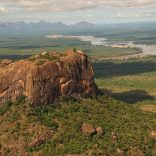Mozambique: 400 animals introduced into Banhine National Park
Elephant population in Gorongosa park up from 200 to 1,000 – scientist

Image: Lusa
The rehabilitation of the Gorongosa National Park, in Mozambique, has increased the number of elephants in the park from 200 to a thousand, but the civil war has left its mark on both the physiognomy and behaviour of the animals, said a scientist.
“Of the 200 elephants – maybe not even 200 – that survived the civil war, now I say with confidence that we have about a thousand elephants in Gorongosa. However, it is not just a number, but we still notice big marks from the past, in their behaviour, in their physiognomy,” ecologist Dominique Gonçalves, who leads the elephant ecology project in Gorongosa National Park, told Lusa.
The population of elephants in Gorongosa fell from 2,500 to around 200 animals due to the civil war in Mozambique, which lasted from 1981 to 1994, but since then the number has increased fivefold, according to figures from the researcher, in an interview with Lusa about her speech at the National Geographic Summit 2022, taking place today in Lisbon.
Gonçalves said, however, that the impact of the war is still noticeable: “In a large percentage of Gorongosa elephants [about 33%], the females do not have tusks. This is due to the selection” that was made by poaching, in which elephants with larger tusks were killed for their ivory.
The young scientist explained that in any population there is always a small percentage of individuals that do not have tusks, but in Gorongosa these were the ones that survived years of killing and are the ones that are reproducing.
“This shows how much human action can not only change the appearance of a species, but also the behaviour,” said the ecologist, recalling that the Gorongosa pachyderms “are famous because of their behaviour, which some call aggressive”, but which Gonçalves prefers to call “protective”.
The elephants of Gorongosa are much less tolerant of people and vehicles than animals in other natural parks. They react by fleeing or attacking, while elsewhere they continue their lives without reacting to tourists, she explained.
Dominique Gonçalves recalled that Gorongosa National Park is an exception to the global trend of declining elephant populations.
Last year, the African forest elephant was listed as critically endangered and the African savanna elephant as endangered on the red list of threatened species of the International Union for Conservation of Nature.
The specialist justified this success, not only with the park’s restoration project underway since 2008, when the Maputo government joined forces with the Carr Foundation, but also with the resident communities around the park, which are “helping a lot to protect the elephants”.
With an area of about 4,067 square kilometres, Gorongosa National Park was once home to one of the densest wildlife populations in all of Africa, including carnivores, herbivores and over 500 species of birds, but the civil war in the country caused 95 per cent of large mammals to disappear and the ecosystems were put under severe pressure.
It is located in Sofala province, at the southern end of the East African Rift Valley, with an area of about 4,000 square kilometres.
The Carr Foundation, created by American Gregory Carr, allied with the Mozambican government to protect the park and in 2008 signed a joint management contract for 20 years, which has since been extended for another 25, committing then to an investment of US$40 million (30.6 million euros at the current exchange rate).
Dominique Gonçalves, who in 2015 joined the Elephant Ecology Project as a researcher, which she now leads, is one of the speakers at the 4th National Geographic Summit, under the motto “One day to change the next”, which brings to Lisbon today “explorers who use the power of science, exploration, research and ‘storytelling’ to publicize and protect the wonders of planet Earth”, according to the organization.













Leave a Reply
Be the First to Comment!
You must be logged in to post a comment.
You must be logged in to post a comment.